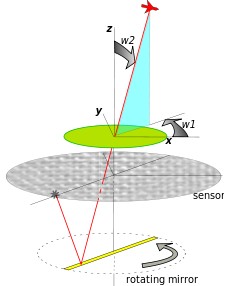
AIM-9 Sidewinder
Wikipedia | 2013-09-30 17:44
| AIM-9 Sidewinder | |
|
An AIM-9 is affixed to an F/A-18 Hornet. |
|
| Type | Short-range air-to-air missile |
| Place of origin | United States |
| Service history | |
| In service | 1956 (AIM-9B) – present |
| Production history | |
| Manufacturer |
Nammo Raytheon Company Ford Aerospace Loral Corp. |
| Unit cost | US$85,000 |
| Produced | September 1953 |
| Specifications | |
| Weight | 188 pounds (85.3 kg) |
| Length | 9 feet 11 inches (3.02 m) |
| Diameter | 5 in (127.0 mm) |
|
|
|
| Warhead | WDU-17/B annular blast-frag |
| Warhead weight | 20.8 lb (9.4 kg) |
|
Detonation mechanism |
Magnetic influence (old models) Active infrared (AIM-9L onwards) |
|
|
|
| Engine | Hercules/Bermite MK 36 Solid-fuel rocket |
| Wingspan | 11 in (279.4 mm) |
|
Operational range |
0.6 to 22 miles (1.0 to 35.4 km) |
| Speed | Mach 2.5 |
|
Guidance system |
Infrared homing |
|
Launch platform |
Aircraft, helicopter gunships |
The AIM-9 Sidewinder is a Infrared homing, short-range, air-to-air missile carried mostly by fighter aircraft and recently, certain gunship helicopters. The missile entered service with the United States Navy in the mid-1950s, and variants and upgrades remain in active service with many air forces after five decades. The United States Air Force purchased the Sidewinder after the missile was developed by the United States Navy at China Lake, California.
The Sidewinder is the most widely used missile in the West, with more than 110,000 missiles produced for the U.S. and 27 other nations, of which perhaps one percent have been used in combat. It has been built under license by some other nations including Sweden. The AIM-9 is one of the oldest, least expensive, and most successful air-to-air missiles, with an estimated 270 aircraft kills in its history of use.
The missile was designed to be simple to upgrade.It has been said that the design goals for the original Sidewinder were to produce a reliable and effective missile with the "electronic complexity of a table model radio and the mechanical complexity of a washing machine"—goals which were well accomplished in the early missiles. The United States Navy hosted a 50th anniversary celebration of its existence in 2002. Boeing won a contract in March 2010 to support Sidewinder operations through 2055, guaranteeing that the weapons system will remain in operation until at least that date. Air Force Spokeswoman Stephanie Powell noted that due to its relative low cost, versatility, and reliability it is "very possible that the Sidewinder will remain in Air Force inventories through the late 21st century."
Launch sequence
When a Sidewinder missile is being launched, most pilots including NATO pilots use the brevity code Fox Two in radio communication, as with all "heat-seeking" missiles.
Name selection
Sidewinder is the common name of Crotalus cerastes, a venomous rattlesnake which uses infrared sensory organs to hunt warm-blooded prey. Early versions of the missile tended to perform zig-zagging course corrections during the early part of their flight path, following a trajectory that resembled the sidewinding motion of the snake.
History
The development of the Sidewinder missile began in 1946 at the Naval Ordnance Test Station (NOTS), Inyokern, California, now the Naval Air Weapons Station China Lake, California as an in-house research project conceived by William B. McLean. McLean initially called his effort "Local Fuze Project 602" using laboratory funding, volunteer help and fuze funding to develop what it called a heat-homing rocket. It did not receive official funding until 1951 when the effort was mature enough to show to Admiral William "Deak" Parsons, the Deputy Chief of the Bureau of Ordnance (BuOrd). It subsequently received designation as a program in 1952. The Sidewinder introduced several new technologies that made it simpler and much more reliable than its United States Air Force (USAF) counterpart, the AIM-4 Falcon, under development during the same period. After disappointing experiences with the Falcon in the Vietnam War, the Air Force replaced its Falcons with Sidewinders.

Geometric arrangement of mirror, IR detector and target.
Share this page



















